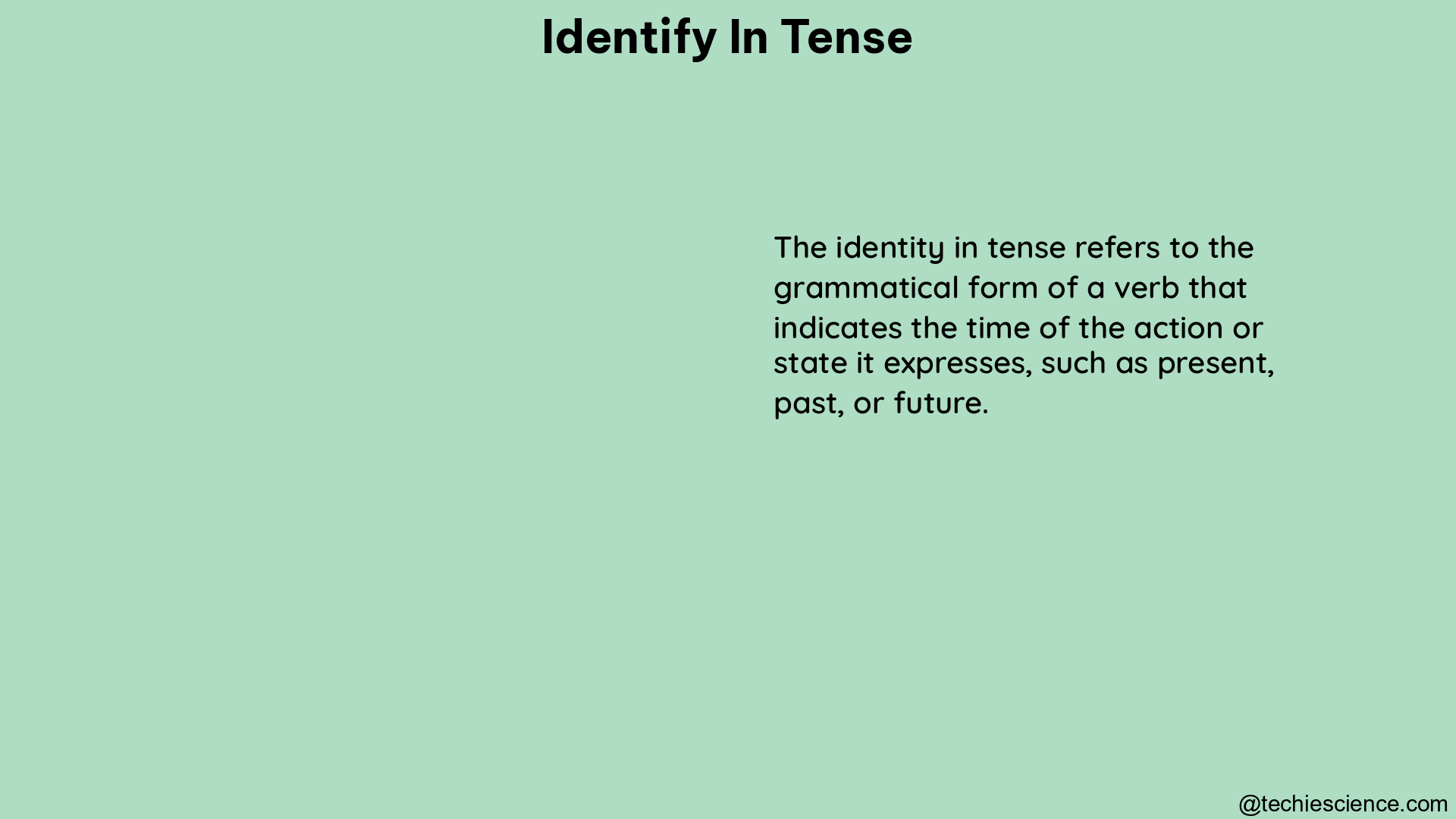Identifying the tense of a sentence is a crucial skill for any English language learner or writer. Understanding the various forms of the verb “identify” and how they are used in different contexts is essential for accurately determining the tense of a sentence. In this comprehensive guide, we will delve into the intricacies of verb conjugation, explore examples of “identify” in different tenses, and provide tools to help you become a master of tense identification.
Conjugation of “Identify”
The conjugation of the verb “identify” is an essential starting point for understanding tenses. Let’s explore the different forms of the verb:
Present Tense
- I identify
- You identify
- He/She/It identifies
- We identify
- They identify
Past Tense
- I identified
- You identified
- He/She/It identified
- We identified
- They identified
Past Participle
- Identified
Present Participle
- Identifying
Examples of “Identify” in Different Tenses

Now that we have a solid understanding of the verb conjugation, let’s dive into examples of “identify” used in various tenses:
- Simple Present:
-
She identifies the problem. (present tense)
-
Present Continuous:
-
They are identifying the issue. (present continuous)
-
Present Perfect:
-
We have identified the solution. (present perfect)
-
Present Perfect Continuous:
-
They have been identifying the patterns. (present perfect continuous)
-
Simple Past:
-
He identified the mistake. (simple past)
-
Past Continuous:
-
They were identifying the errors. (past continuous)
-
Past Perfect:
-
We had identified the problem. (past perfect)
-
Past Perfect Continuous:
-
They had been identifying the trends. (past perfect continuous)
-
Simple Future:
-
They will identify the issue. (simple future)
-
Future Continuous:
- We will be identifying the opportunities. (future continuous)
-
Future Perfect:
- They will have identified the solution. (future perfect)
-
Future Perfect Continuous:
- We will have been identifying the challenges. (future perfect continuous)
Identifying Tenses in Sentences
To accurately identify the tense of a sentence, you need to pay attention to the verb form and its context. Here are some examples to help you understand the process:
- “She is teaching her students.” – Present Continuous
- “We have been waiting for them.” – Present Perfect Continuous
- “He eats with his left hand.” – Simple Present
- “They will have learnt their lessons.” – Future Perfect
Tools for Identifying Tenses
While understanding the conjugation and examples of “identify” in different tenses is crucial, there are also online tools available that can assist you in identifying the tense of a sentence. One such tool is the Sentence Tense Identifier, which can provide you with a quick and accurate analysis of the tense used in a given sentence.
Advanced Techniques for Tense Identification
Beyond the basic understanding of verb conjugation and tense examples, there are several advanced techniques you can employ to become a true master of tense identification:
-
Contextual Analysis: Carefully examine the surrounding words, phrases, and overall context of the sentence to determine the appropriate tense. This can help you identify more complex tense usage, such as shifts between tenses within a single sentence.
-
Verb Phrase Identification: Recognize the structure of the verb phrase, including any auxiliary verbs (e.g., “have,” “will,” “be”) that can indicate the tense.
-
Temporal Adverbs and Phrases: Pay attention to the use of adverbs and phrases that provide temporal information, such as “yesterday,” “currently,” “will,” or “has been,” as they can offer clues about the tense being used.
-
Passive Voice Constructions: Understand how the passive voice can affect the tense of a sentence, as the auxiliary verb “be” can change the overall tense.
-
Irregular Verb Forms: Be familiar with common irregular verb forms, as they may not follow the standard conjugation patterns, which can impact tense identification.
-
Tense Consistency: Recognize when a writer shifts between tenses within a passage or text, and understand the purpose and effect of such tense changes.
By mastering these advanced techniques, you will be able to confidently and accurately identify the tense of any sentence, even in complex or ambiguous cases.
Conclusion
Identifying the tense of a sentence is a fundamental skill for any English language learner or writer. By understanding the conjugation of the verb “identify,” exploring examples of its use in different tenses, and utilizing various tools and advanced techniques, you can become a true expert in tense identification. This comprehensive guide has provided you with the knowledge and resources necessary to master this essential aspect of the English language. Embrace the challenge, practice regularly, and watch your tense identification skills soar to new heights.
References
- https://www.wordreference.com/conj/enverbs.aspx?v=identify
- https://www.reddit.com/r/grammar/comments/1beaatw/identify_that_tense/
- https://www.englishgrammar.org/identify-tenses-2/

Hi…..I’m a graduate with a Bachelor’s degree in English Literature. I wish to do a Masters in the same field someday and continue my career in Academia.
Let’s connect through LinkedIn: